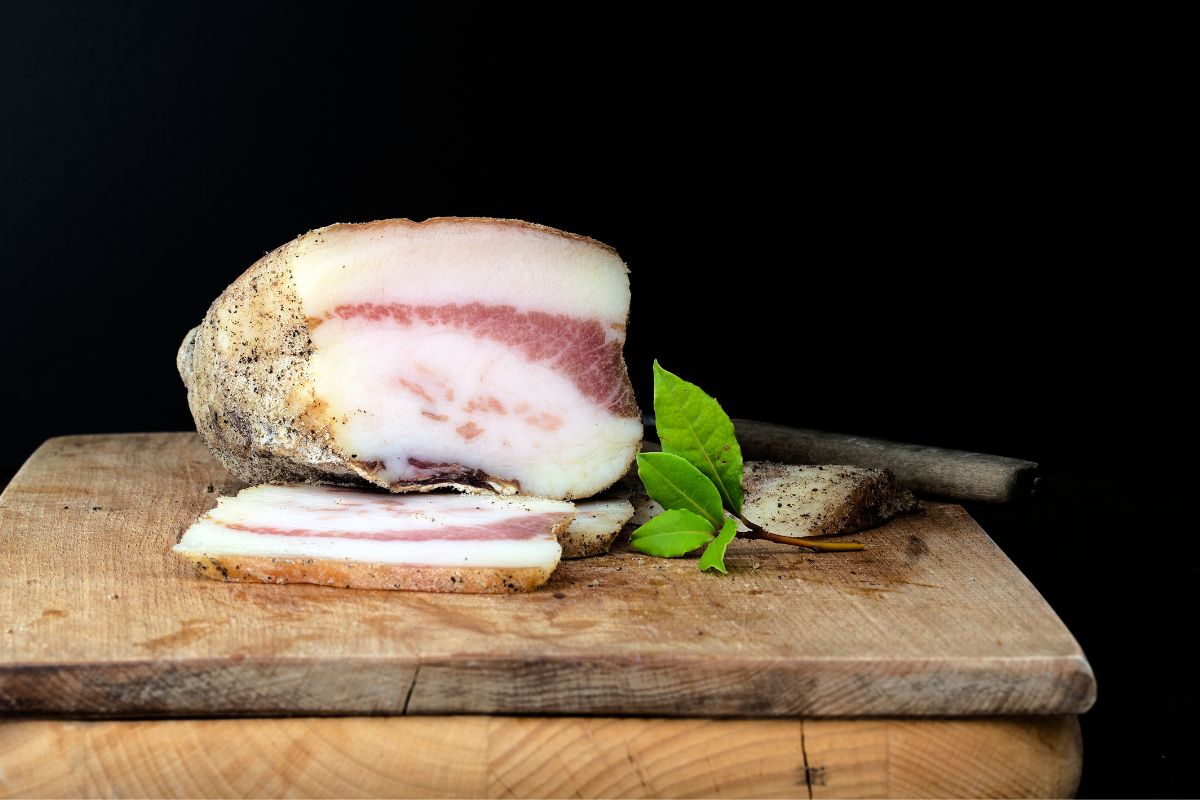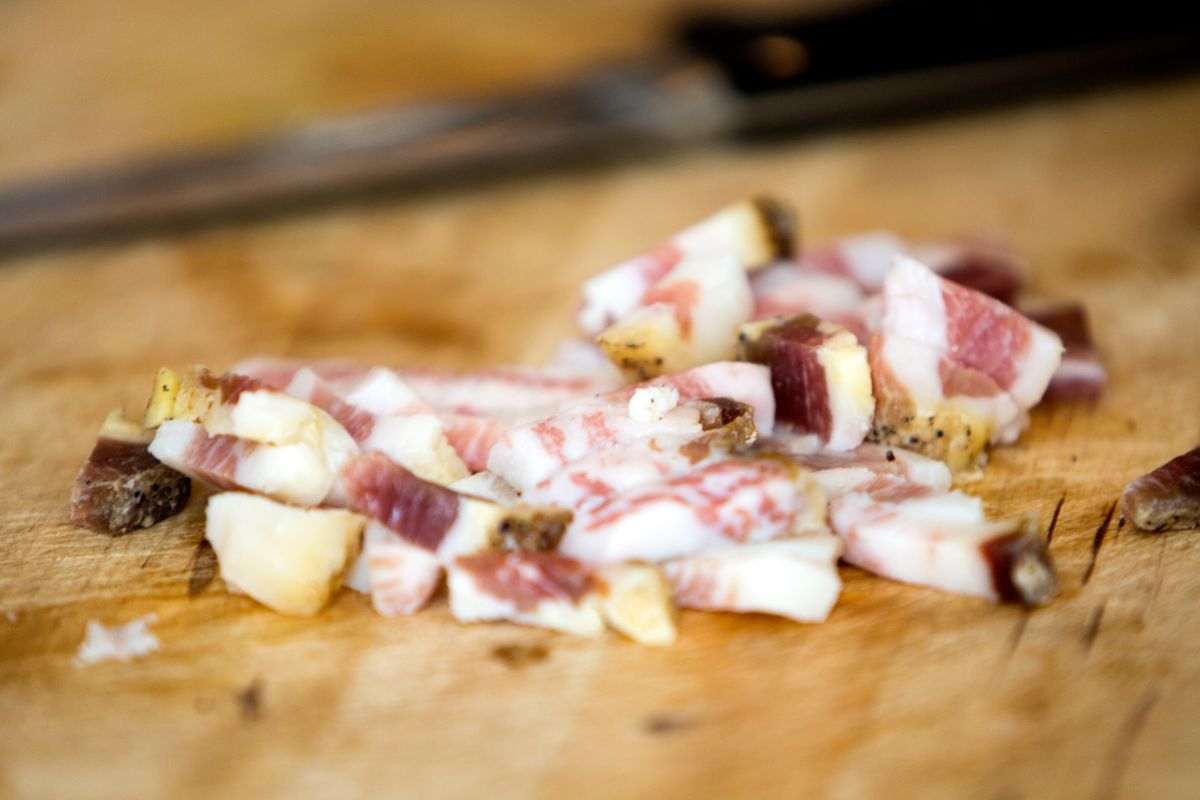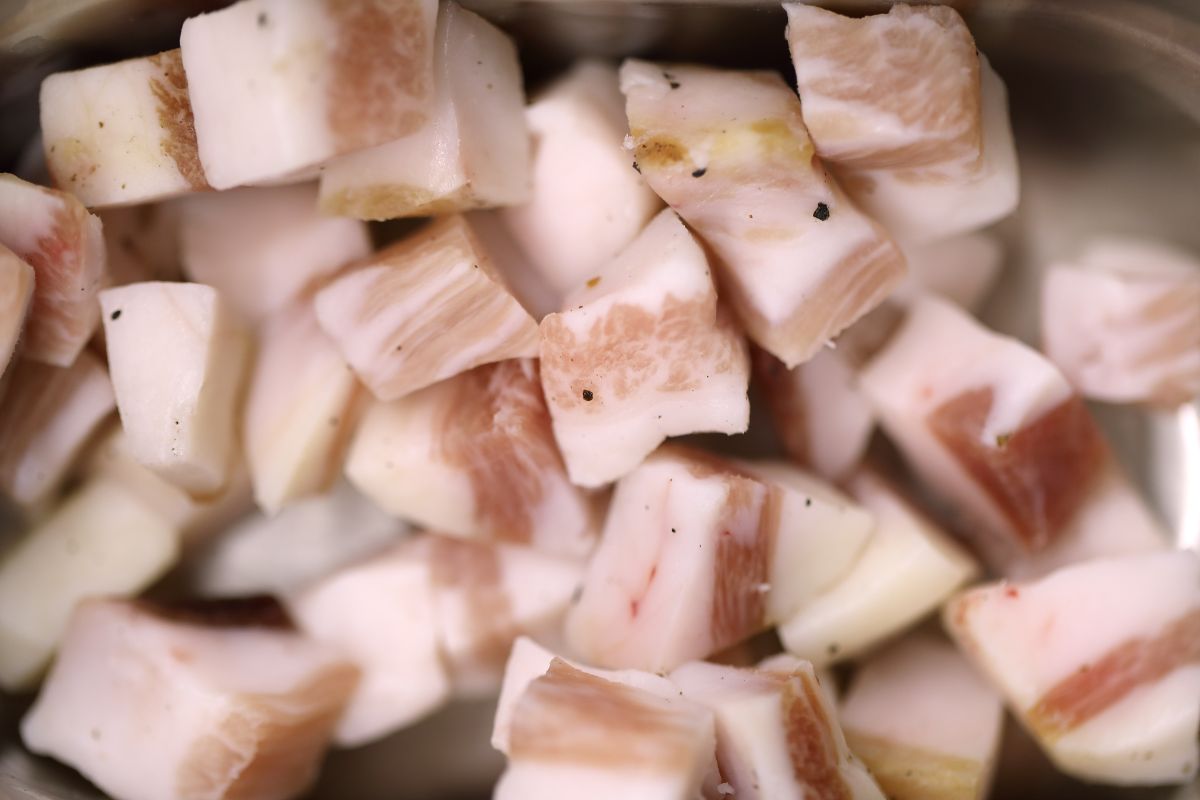What is Guanciale?
Guanciale is a pork jowl that undergoes curing; you add it to pasta, risotto, and stews to enhance flavor and richness. When preparing Guanciale, where to buy is somehow a concern.
This Italian beef has a lot of tasty fat and meat striations. You can season Guanciales with black pepper, garlic, and rosemary. Guanciale is common in the Italian dish Pasta all amatriciana, where you cube and cook till crispy.

Where to Buy Guanciale
Are you wondering where to buy Guanciale? Worry not; follow the link below and enjoy your recipe;
Tempesta Guanciale (Pork Jowls), 14 OZ (Pack – 6)
Brand: Tempesta
Size: Pack of 6
Weight:14 ounces (396.9 grams)
Allergen Information: Gluten-Free
Description
Guanciale is a fatty cut from the jowls on the sides of the pig’s head. Though many people confuse it with belly pork, the cheek has distinct flavors that make it equally at home, thinly sliced, and you eat out of hand as it is in a pan sauce or soup. The muscle works more than the belly since the pig chews all day.
This indicates it contains more active fibers, which gives it a stronger flavor. The fatty Guanciale will melt in your mouth if you eat out of hand due to Berkshire’s propensity to store fat with its lean muscle. The fat within those meat fibers, which you can not find in belly meat, will also break down, making it superior to any pancetta in rendering for a dish.
There will be fewer hard, dedicated lean parts in the end dish. Instead, each guanciale bite will surrender to the chew, releasing more flavor with each bite. Guanciale is hence the recommended salumi for recipes such as pasta all’ amatriciana, carbonara, and gricia.
You can use fresh herbs, tellicherry pepper, garlic, fennel pollen, and a touch of Calabrian pepper to season heritage Berkshire and Duroc hog jowl. A best-seller in the United States.
There are no nitrites or nitrates added other than those you find naturally in sea salt and celery powder.
Specifications and information
- Salumi is a product of artisans. Berkshire pork is an ingredient in this dish.
- There are no hormones or growth promoters in this product.
- There are no nitrites or nitrates added other than those you find naturally in sea salt and celery powder.
- Serve thinly sliced or mix it into your next pasta sauce. Dice the hot Guanciale and toss it into carbonara or amatriciana pasta for those who enjoy a kick of heat.

How to Eat Guanciale
Guanciale meat looks and tastes like bacon or pork belly, and you can use it in recipes that call for such items. You can use diced Guanciale in sauces, soups, and pasta dishes. You can also cut and pan-fry for a tasty appetizer. This Italian meat gives your food a delicious saltiness and buttery flavor.
The following is one Guanciale Recipe you can try out;
Spaghetti With Guanciale and Cheese
Time: 30 minutes
Serving size: 2 servings
Prep time: 10 minutes
Cook time: 20 minutes
Ingredients
- Kosher salt, to taste
- 1 tablespoon olive oil
- 7 ounces (198.4 grams) guanciale, cut into 1½-by-½-inch (3.81 by 1.27 centimeters) strips
- 1 pound (2.54 kilograms) spaghetti
- 1 cup grated Pecorino Romano; add more for garnish
- Freshly ground pepper, to taste
- ½ cup white wine
- Cheese
Preparation
- On high heat, boil a large pot of water. Using salt, season the water –cook for nine to 11 minutes, or until the pasta is al dente. Drain a cup of the cooking liquid and set it aside.
- Meanwhile, heat the olive oil in a large skillet over medium heat. Cook, frequently turning, until the Guanciale is golden brown, about 10 to 12 minutes.
- Cook for two minutes or until the white wine somewhat decreases. Bring the remaining one cup of cooking liquid to a low simmer.
- Toss in the noodles and grated cheese to combine. Cook, constantly stirring, for another two to three minutes, or until a thick sauce develops. Add salt and pepper to taste.
- Serve by dividing the spaghetti among plates and garnishing it with extra shredded cheese and freshly ground black pepper.
Three Ways to Prepare Guanciale
You can eat Guanciale alone, as a savory complement to pasta, or broccoli rabe greens. Here are a few different ways to prepare Guanciale.
- Baked: Cut Guanciale into thin strips and bake until crispy, like bacon. Brush a baking pan with oil and bake for fifteen minutes at 201 degrees Celsius (395 degrees Fahrenheit). In Italian recipes, you can serve sautéed Guanciale with robust fava beans or bitter greens like broccoli rabe. Prepare your beans or greens separately, then sauté in a pan with Guanciale.
- Pan-fried: The most famous Italian pasta dishes with Guanciale as the main component (spaghetti alla carbonara, bucatini all amatriciana, and pasta alla gricia) all call for it to pan-fry until the fat renders. The rendered fat produces a flavorful oil that you can use to coat pasta and flavor other dishes.

Guanciale, Porkers Delight!
Guanciale has a buttery, creamy flavor with a delicate sweet-savory balance. It’s flavorful and delicious because of the high fat-to-meat ratio. Guanciale has a flavor comparable to bacon, but it has some richer flavor and a slightly softer texture.

Community of passionate writers and content creators who share a love for Italian heritage, culture, travel, food, and the Italian-American community. Our mission is to celebrate Italy’s rich history and traditions and connect with others who share the same passion.


